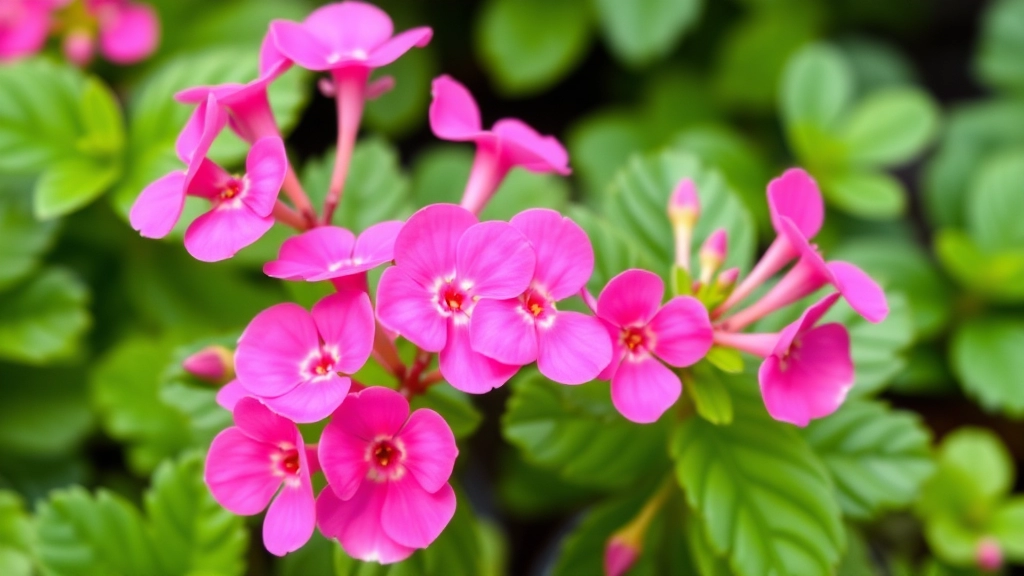Hot Pink Kalanchoe Plant Care Guide
If you’re looking to add a splash of vibrant colour to your indoor garden, the Hot Pink Kalanchoe Plant is a fantastic choice. This striking succulent not only brightens up any space with its vivid blooms but is also relatively low-maintenance. In this guide, I’ll share practical tips on how to care for and grow your Hot Pink Kalanchoe to ensure it thrives.
Ideal Growing Conditions
First off, let’s talk about the ideal growing conditions. A Hot Pink Kalanchoe Plant flourishes in well-draining soil and requires moderate watering—too much water can lead to root rot. Place your plant in a spot where it can receive plenty of indirect sunlight to promote those stunning hot pink flowers. With the right care, your Kalanchoe will be a showstopper in any room.
Best Growing Conditions for Hot Pink Kalanchoe
Are you struggling to keep your Hot Pink Kalanchoe thriving?
Understanding its best growing conditions is essential for vibrant blooms and healthy foliage.
Ideal Temperature
Kalanchoe plants prefer a warm environment.
- Optimal Range: 20-25°C (68-77°F) during the day.
- Nighttime: They can tolerate cooler temperatures, ideally not dropping below 10°C (50°F).
Humidity Levels
Humidity plays a crucial role in the health of your Kalanchoe.
- Low Humidity: These plants thrive in dry conditions, making them perfect for indoor environments.
- Avoid Excess Moisture: High humidity can lead to fungal issues.
Location
Choosing the right spot in your home can make all the difference.
- Bright, Indirect Light: Kalanchoe loves light but can scorch in direct sunlight.
- Indoor Placement: A south or west-facing window is ideal.
Air Circulation
Good airflow is key to preventing disease.
Watering Requirements for Optimal Growth
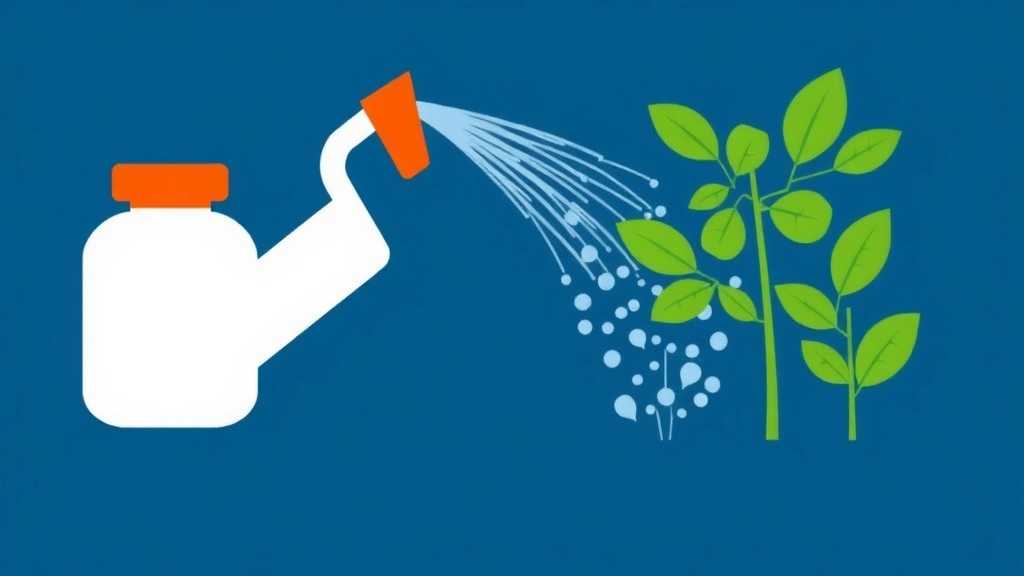
So, you’ve got your hot pink Kalanchoe, and now you’re wondering how much water it really needs, right?
Let’s dive into the watering game because it’s crucial for keeping your plant vibrant and blooming.
Understanding Your Kalanchoe’s Needs
Kalanchoe is a succulent, which means it stores water in its leaves. This gives it a bit of a buffer when it comes to watering. Here’s what you should keep in mind:
- Less is More: It’s better to underwater than overwater. Kalanchoe thrives on neglect rather than being drenched.
- Check the Soil: Stick your finger about an inch into the soil. If it’s dry, it’s time to water; if it’s still moist, hold off.
- Watering Schedule: During the growing season (spring and summer), aim to water every 2-3 weeks. In autumn and winter, you can stretch it to once a month.
- Drainage is Key: Always ensure your pot has drainage holes. Standing water can lead to root rot, which is a nightmare for your plant.
Signs of Overwatering
Keep an eye out for these signs:
- Yellowing Leaves: If the leaves start turning yellow, you might be giving it too much love (a.k.a. water).
- Soft and Mushy Leaves: This is a clear red flag that your Kalanchoe is drowning.
Tips for Effective Watering
- Use Room Temperature Water: Cold water can shock your plant. Warm it up a bit before pouring.
- Water Thoroughly: When you do water, make sure to soak the soil completely. Let it drain out the bottom.
- Adjust for Climate: If it’s hot and dry, you might need to water a bit more often. Conversely, in humid conditions, you can ease up.
Soil Type and Potting Tips for Kalanchoe
When it comes to growing a vibrant Hot Pink Kalanchoe, the right soil and potting techniques play a crucial role. Many plant enthusiasts often wonder, “What type of soil is best for my Kalanchoe?”
Ideal Soil Type
Kalanchoe thrives in well-draining soil. Here are some key points to consider:
- Cactus or Succulent Mix: A pre-made cactus or succulent mix is ideal, as it allows for proper drainage.
- DIY Mix: If you prefer to create your own, combine:
- 2 parts potting soil
- 1 part perlite or coarse sand
- 1 part peat moss
This blend ensures that excess water can escape, preventing root rot.
Potting Tips
Choosing the right pot and potting technique is equally important. Here are some straightforward tips:
- Pot Size: Use a pot that is slightly larger than the root ball. This provides space for growth without overwhelming the plant.
- Drainage Holes: Ensure the pot has drainage holes to allow excess water to escape.
- Repotting: Repot every couple of years or when you notice roots growing out of the drainage holes. This refreshes the soil and promotes healthy growth.
Example Scenario
Imagine you’ve just bought a beautiful Hot Pink Kalanchoe. You decide to pot it in a terracotta pot with a succulent mix. After a few weeks, you notice it thriving, with vibrant blooms and healthy leaves. This is the result of the right soil and potting techniques!
For more detailed advice on caring for your Kalanchoe, check out our Care Guide for Hot Pink Kalanchoe. If you are interested in exploring different species, visit our Guide to Different Kalanchoe Species.
Sunlight Needs: Maximizing Bloom Intensity
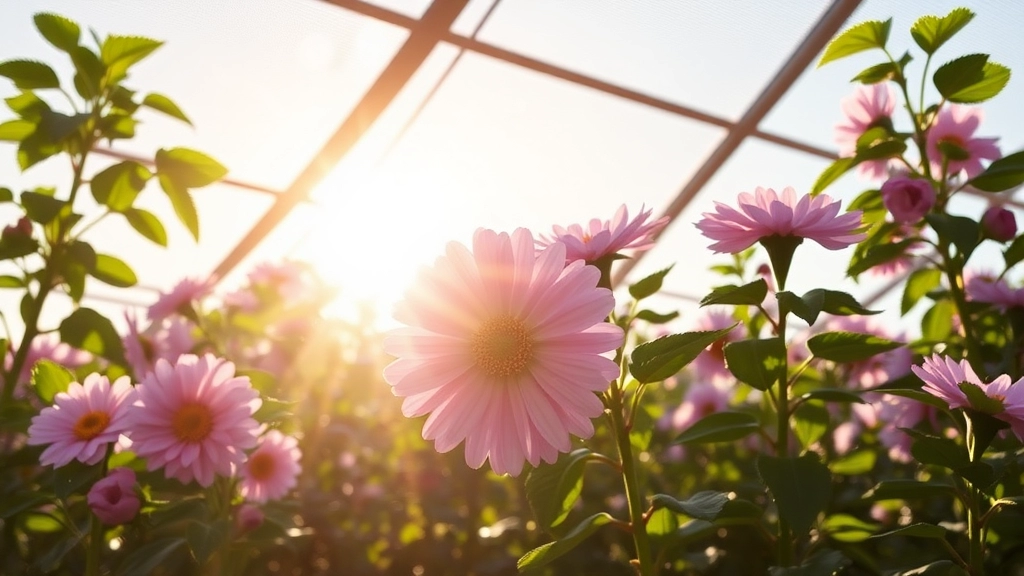
Are you struggling to get your Hot Pink Kalanchoe to bloom as vibrantly as you’d like?
Understanding its sunlight needs is crucial for achieving those stunning, intense blooms.
Optimal Sunlight Exposure
Hot Pink Kalanchoe thrives in bright, indirect sunlight. Here are some key points to consider:
- Direct Sunlight: While these plants enjoy light, avoid placing them in harsh, direct sunlight for extended periods. This can scorch their leaves.
- Indirect Light: Aim for a spot where they receive plenty of bright, filtered light. A south or west-facing window is often ideal.
- Duration: Ideally, they should get around 6 hours of indirect sunlight daily. This helps stimulate blooming and keeps the foliage healthy.
Signs of Inadequate Light
If your Kalanchoe isn’t getting enough light, you might notice:
- Stretching: The plant may become leggy as it reaches for more light.
- Fading Blooms: Flowers may lose their vibrancy and appear dull.
Seasonal Adjustments
As the seasons change, so should your plant’s location:
- Winter: During the shorter days, consider moving your Kalanchoe closer to the window to maximise light exposure.
- Summer: Monitor for signs of sunburn and adjust its position if needed.
Seasonal Care for Your Hot Pink Kalanchoe
As we shift through the seasons, your Hot Pink Kalanchoe will require different care to thrive.
Spring: Awakening Growth
In spring, your Kalanchoe begins to awaken from its winter dormancy. This is the ideal time to:
- Repot: If your plant has outgrown its pot, consider repotting into a slightly larger container.
- Watering: Increase watering as temperatures rise, ensuring the soil remains slightly moist but not soggy.
- Fertilize: Start a regular fertilization schedule every 4-6 weeks with a balanced, water-soluble fertilizer.
Summer: Peak Blooming Season
Summer is when your Kalanchoe will likely show off its vibrant blooms. During this time:
- Sunlight: Ensure it receives ample sunlight, ideally 6 hours of bright, indirect light daily.
- Humidity: Monitor humidity levels; if the air is too dry, consider misting the leaves lightly.
- Pest Check: Keep an eye out for pests like aphids and mealybugs, which can become more active in warmer weather.
Autumn: Preparing for Dormancy
As autumn approaches, your Kalanchoe will start to slow down. Here’s how to prepare it for the cooler months:
- Reduce Watering: Cut back on watering as the plant will require less moisture.
- Pruning: Trim back any spent flowers to encourage new growth in the spring.
- Light Adjustment: If indoors, ensure it still gets plenty of indirect light, especially as days grow shorter.
Winter: Dormancy
During winter, your Kalanchoe enters a dormant phase. To care for it during this time:
Common Pests and How to Prevent Infestations
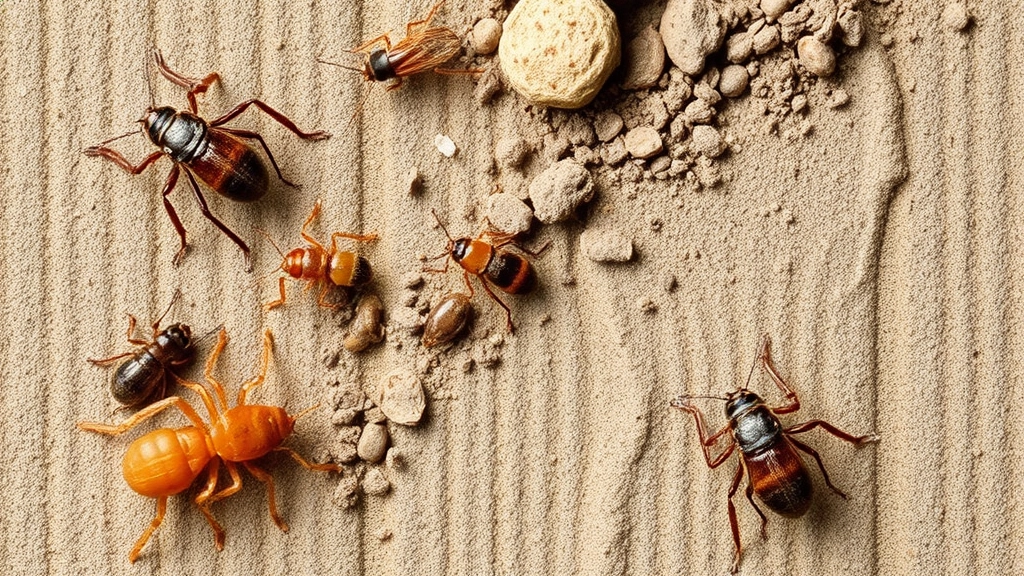
Have you ever noticed tiny critters on your beloved Hot Pink Kalanchoe? It’s a real worry for many plant lovers. Pests can sneak in and wreak havoc, but don’t fret! Let’s dive into how to keep your Kalanchoe safe and thriving.
Common Pests to Watch For
- Mealybugs
- These little white fluff balls love to hide in leaf joints.
- They suck the sap, which can weaken your plant.
- Aphids
- Tiny and green, they can be hard to spot.
- They multiply quickly and can distort your plant’s growth.
- Spider Mites
- These are super small, often hiding under leaves.
- They create fine webs and can cause yellowing.
- Scale Insects
- They look like small bumps on the stems and leaves.
- They can cause leaf drop if not dealt with.
Prevention Tips
Keeping your Kalanchoe pest-free is easier than you might think. Here are some simple steps:
- Regular Inspection
- Check your plant weekly.
- Look under leaves and in the leaf joints.
- Maintain Cleanliness
- Wipe leaves with a damp cloth to remove dust.
- This makes it harder for pests to settle in.
- Use Neem Oil
- A natural pesticide that’s safe for your plant.
- Spray it every few weeks as a preventative measure.
- Keep Air Circulation Good
- Ensure your plant isn’t overcrowded.
- Good airflow can help deter pests.
- Quarantine New Plants
- Always keep new additions away from your existing plants for a few weeks.
- This way, you can spot any pests before they spread.
Fertilizing for Long-lasting Blooms
When it comes to keeping your Hot Pink Kalanchoe vibrant and blooming, understanding its fertilization needs is crucial. Many plant enthusiasts often wonder how to ensure their Kalanchoe remains healthy and produces an abundance of flowers.
Choosing the Right Fertilizer
To promote long-lasting blooms, opt for a balanced, water-soluble fertilizer. Look for one with a ratio such as 20-20-20 or 15-30-15, which provides essential nutrients.
- Frequency: Fertilize every 4-6 weeks during the growing season (spring and summer).
- Dilution: Always dilute the fertilizer to half-strength to avoid burning the roots.
- Application: Apply the fertilizer directly to moist soil to help absorption.
Organic Options
If you prefer organic methods, consider using:
- Fish emulsion: Provides a rich source of nitrogen.
- Compost tea: Boosts overall plant health and encourages blooming.
Signs of Nutrient Deficiency
Watch for signs that your Kalanchoe might need a boost:
- Pale leaves: Indicates a lack of nitrogen.
- Poor blooming: May suggest insufficient phosphorus.
By keeping an eye on these signs, you can adjust your fertilization routine accordingly. For more detailed care tips, check out our care tips for thriving Kalanchoe red flower plants. Additionally, if you’re experiencing issues with your plant’s leaves, our guide on why Kalanchoe leaves dry out may provide useful solutions.
How to Prune and Shape Your Kalanchoe
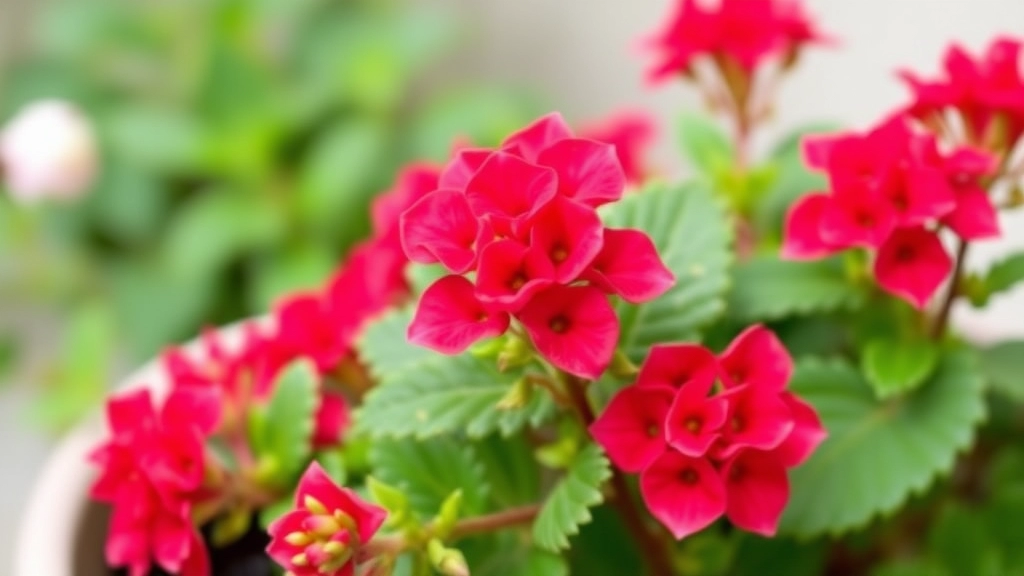
So, you’ve got your hot pink Kalanchoe blooming beautifully, but have you thought about how to keep it looking its best? Pruning is key to maintaining its shape and encouraging more vibrant flowers.
Why Prune?
- Encourages Growth: Snipping off dead or wilted flowers promotes new growth.
- Shapes the Plant: Keeps your Kalanchoe looking tidy and full.
- Prevents Disease: Removing unhealthy leaves can help keep pests and diseases at bay.
When to Prune
- After Blooming: The best time to prune is right after the blooming season. This is when your plant will benefit most from a good trim.
- Regular Maintenance: You can also do light pruning throughout the year to shape it and remove any dead leaves.
How to Prune
- Gather Your Tools: You’ll need sharp scissors or pruning shears.
- Identify the Right Spots: Look for wilted flowers or leaves.
- Cut at the Base: For flowers, cut just above the first set of healthy leaves. For leaves, snip them off at the base.
- Don’t Overdo It: Aim to remove about one-third of the plant at a time to avoid stressing it.
Shaping Your Kalanchoe
- Keep It Balanced: Trim evenly around the plant to maintain a nice shape.
- Encourage Bushiness: Cut the top stems to promote side growth, making your Kalanchoe fuller.
Aftercare
- Water Sparingly: After pruning, give it a little water but don’t overdo it.
- Watch for Growth: Keep an eye on your plant; it should start sprouting new growth soon!
Propagation Techniques: Growing New Plants from Cuttings
If you’ve enjoyed caring for your Hot Pink Kalanchoe, you might be wondering how to multiply its beauty in your home. Propagation is a rewarding process that allows you to create new plants from cuttings of your existing Kalanchoe.
Why Propagate?
- Cost-effective: Instead of buying new plants, you can grow them from cuttings.
- Personalisation: You can create a collection of Kalanchoe in various pots and locations.
- Sharing: It’s a thoughtful gift for friends and family who appreciate plants.
Steps for Successful Propagation
- Choose Healthy Cuttings:
- Look for stems that are firm and free of blemishes.
- Aim for cuttings that are at least 3-4 inches long.
- Make the Cut:
- Use clean, sharp scissors or pruning shears to avoid damaging the plant.
- Cut just below a leaf node, as this is where roots will develop.
- Let Them Callous:
- Place the cuttings in a dry, shaded area for a few days.
- This allows the cut ends to callous over, reducing the risk of rot.
- Prepare the Soil:
- Use a well-draining potting mix, ideally a cactus or succulent mix.
- Fill small pots or trays with the soil, leaving space for the cuttings.
- Plant the Cuttings:
- Insert the calloused end of each cutting into the soil about an inch deep.
- Firm the soil around the cutting to ensure stability.
- Water Sparingly:
- Lightly mist the soil to moisten it without soaking.
- Avoid overwatering, as this can lead to rot.
- Create a Humid Environment:
- Cover the pots with a plastic bag or a clear plastic dome to maintain humidity.
- Ensure there’s some airflow to prevent mould.
- Provide Indirect Light:
- Place the cuttings in a bright area but out of direct sunlight.
- Too much sun can scorch the cuttings before they root.
Monitoring Growth
- Check for Roots:
- After a few weeks, gently tug on the cuttings. If you feel resistance, roots are forming.
- Transplanting:
- Once roots are established, you can transplant them into individual pots.
This method of propagation is not only straightforward but also allows you to enjoy the beauty of Hot Pink Kalanchoe in multiple spots around your home. For more detailed steps, you can refer to our step-by-step guide on propagating Kalanchoe. Additionally, if you are interested in other varieties, check out our guide on buying and caring for Kalanchoe plants.
Troubleshooting Issues: Yellowing Leaves and Root Rot
So, you’ve noticed your hot pink Kalanchoe isn’t looking its best. Yellowing leaves and root rot can be real bummers, but don’t worryâI’ve got your back.
Yellowing Leaves
Seeing those vibrant leaves turn yellow can feel like a disaster, but it’s usually a sign that something’s off. Here are a few common culprits:
- Overwatering: This is the top reason for yellowing leaves. Kalanchoes prefer to dry out a bit between waterings.
- Nutrient Deficiency: If your plant isn’t getting enough nutrients, it might show signs of stress. A balanced fertiliser can help.
- Poor Light Conditions: Too little light can lead to yellow leaves. Make sure your Kalanchoe gets bright, indirect sunlight.
Quick Fixes for Yellow Leaves
- Check the soil moisture. If it’s soggy, hold off on watering.
- Consider a fertiliser boost, especially if it’s been a while since you last fed your plant.
- Move your Kalanchoe to a brighter spot, but avoid direct sunlight to prevent scorched leaves.
Root Rot
Now, if you’ve got yellow leaves and a mushy smell coming from the soil, root rot might be the issue. This is a serious problem, but you can tackle it:
- Signs of Root Rot: Look for black, mushy roots and a general wilting appearance, even if the soil is wet.
- Causes: Overwatering is usually to blame, but poor drainage can also contribute.
How to Handle Root Rot
- Remove the Plant: Gently take your Kalanchoe out of its pot.
- Inspect the Roots: Cut away any black, mushy roots with clean scissors.
- Repot: Use fresh, dry soil and a pot with good drainage holes.
Taking these steps can breathe new life into your Kalanchoe. For more detailed care information, check out our Flower Dust Plant Care Guide and learn the Causes and Solutions for Non-Flowering Kalanchoe.
FAQs: Hot Pink Kalanchoe Plant
How often should I water my Hot Pink Kalanchoe?
During the growing season (spring and summer), water every 2-3 weeks. In autumn and winter, you can extend it to once a month. Always check the soil; if it’s dry an inch deep, it’s time to water.
What type of sunlight does my Hot Pink Kalanchoe need?
Your Kalanchoe thrives in bright, indirect sunlight. Aim for about 6 hours of indirect light daily. Avoid harsh, direct sunlight to prevent leaf scorch.
How can I tell if my Kalanchoe is overwatered?
Signs of overwatering include yellowing leaves and soft, mushy leaves. If you notice these symptoms, reduce your watering frequency.
What are common pests that affect Kalanchoe, and how can I prevent them?
Common pests include mealybugs, aphids, spider mites, and scale insects. Prevent infestations by regularly inspecting your plant, maintaining cleanliness, using neem oil, ensuring good air circulation, and quarantining new plants.
When is the best time to prune my Hot Pink Kalanchoe?
The best time to prune is right after the blooming season. Regular maintenance pruning can be done throughout the year to shape the plant and remove dead leaves.
How should I prune my Kalanchoe to keep it healthy?
Use sharp scissors or pruning shears. Cut wilted flowers just above the first set of healthy leaves and remove dead leaves at the base. Avoid removing more than one-third of the plant at a time to prevent stress.
What should I do after pruning my Kalanchoe?
After pruning, water the plant sparingly and monitor it for new growth. This will help it recover and encourage further blooming.
How do I ensure my Kalanchoe blooms vibrantly?
Ensure it gets around 6 hours of bright, indirect sunlight daily. Adjust its position seasonally to maximize light exposure and avoid harsh direct sunlight.
What are the signs that my Kalanchoe isn’t getting enough light?
If your Kalanchoe isn’t getting enough light, you might notice it becoming leggy as it reaches for more light, and the blooms may fade and appear dull.
How can I shape my Kalanchoe for a fuller appearance?
Trim evenly around the plant to maintain balance and cut the top stems to encourage side growth. This will make your Kalanchoe appear fuller and bushier.
References
-
Kalanchoe Plant Watering: How Often Should You Water Kalanchoe?
-
How to Grow and Care for Kalanchoe Indoors
-
How to Grow Kalanchoe
